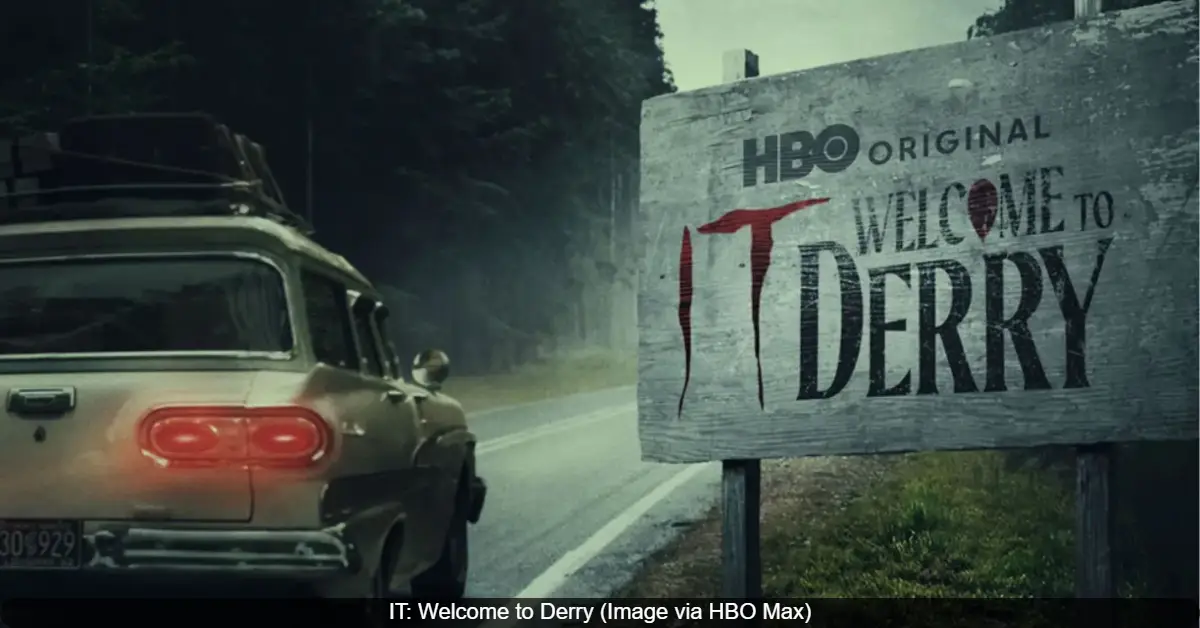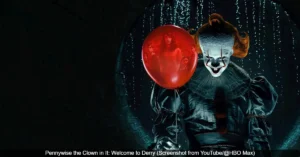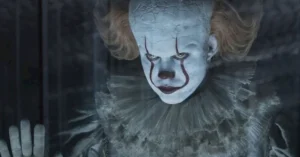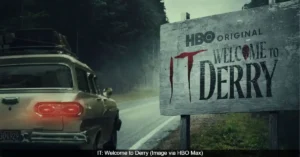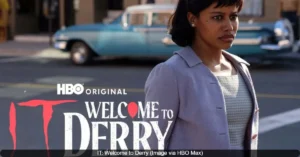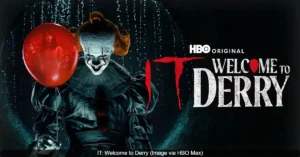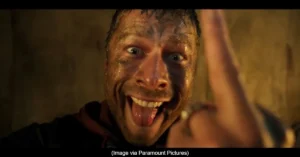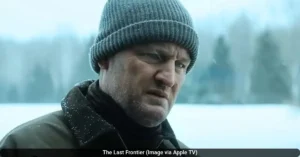The town of Derry’s dark history is finally unveiled in “It: Welcome to Derry,” the new HBO prequel series that premiered on October 26, 2025. Set in 1962, the show explores the origins of Pennywise the Clown and the cursed town he inhabits, serving as a direct prequel to the 2017 and 2019 “It” films. Early reviews suggest the series is a terrifying expansion of Stephen King’s world that cleverly blends supernatural scares with real-world social commentary.
What Is Welcome to Derry About?
Set 27 years before the events of the “It” movies, “Welcome to Derry” begins in 1962 with the arrival of a new family in the seemingly quiet town of Derry, Maine. U.S. Air Force Major Leroy Hanlon moves with his wife Charlotte and their 12-year-old son Will, just as a young boy mysteriously disappears. The series follows a group of kids who realize that something is terribly wrong in their town and that the adults are either unable or unwilling to see the truth.
The narrative weaves together multiple storylines, including the Hanlon family’s experience with racism at the local Air Force base and the children’s investigation into the town’s dark secrets. The show introduces viewers to a new ensemble, including Lilly, a girl returning from a stay at Juniper Hill asylum; Ronnie, a Black classmate facing ostracization; and their friends who band together to uncover what’s happening in Derry.
How Does It Compare to the It Movies?
Critics note that the series successfully builds upon the foundation laid by the previous films while carving its own identity. The show has been described as a “total monster mash that should satisfy hungry horror fans” and “precision-tooled prestige horror.”
The series reportedly confronts the theme of “the everyday violence we ignore” with “far more courage and way more creativity than the franchise’s past two film adaptations.” Some reviewers feel more invested in this cursed Maine community and its lore than they were at any point during the movies, praising the expansion of King’s mythology.
However, not all comparisons are favorable. Some critics feel the series lacks the “charismatic kid characters, the dread-drenched tension, or tangible atmosphere” of the first film, while others note it sometimes struggles with tone, vacillating “between imaginative, Nightmare on Elm Street-style terror and the juvenile thrills of Goosebumps.”
Is the Show Truly Scary?
According to early reviews, “Welcome to Derry” delivers genuine scares. The series has been called “knuckle-gnawing, hair-raisingly scary — a terrifying tour de force” that isn’t pulling any punches when it comes to horror.
The show features graphic violence, with one review noting that “even the first episode features moments far more disturbing than anything in either It films.” Another critic highlighted “an insane body-horror sequence the likes of which I have never seen before.”
The horror operates on multiple levels, with the show’s most frightening aspects possibly being its “moments of real-world anxiety” that contrast with the supernatural terror of Pennywise.
How Much Pennywise Do We See?
Bill Skarsgård returns as the iconic Pennywise the Clown, though his screen time is reportedly limited in the early episodes. Reviews indicate that “audiences shouldn’t hold their breath waiting for his arrival,” and there’s “nowhere near enough Pennywise” in the first five episodes provided for review.
However, when Skarsgård does appear, he “continues to demonstrate why his Pennywise is a modern horror icon” and “makes the most of the few minutes he’s on-screen.” The series uses Pennywise more as a “shape-shifting creature” that enhances the show with a higher variety of scares beyond just the clown form.
What About the Cast?
The series features an ensemble cast that has received widespread praise. Jovan Adepo portrays Major Leroy Hanlon, with Taylour Paige as his wife Charlotte and Blake Cameron James as their son Will. Among the adult cast, Adepo’s performance has been highlighted as a standout, with his storyline being “one of the biggest reasons why I was invested.”
The younger cast members have also earned praise, with critics noting “it cannot be overstated how outstanding the younger cast is” and that their “emotional depth and depictions of fright and panic really elevate It: Welcome to Derry.” Clara Stack’s performance as Lilly particularly stands out as “a young girl still terrorized by the traumatic loss of her father, but desperate to save her friends.”
Does It Honor Stephen King’s Novel?
The series draws heavily from King’s original work, with one reviewer noting that “a lot of the storylines that unfold here are taken directly from that massive tome of terror.” The show elaborates on flashbacks and incidents from the novel that were previously only briefly mentioned.
The series also deepens the connection to King’s broader literary universe, featuring characters like Dick Hallorann (played by Chris Chalk), who appears in “The Shining,” and including plenty of Easter eggs for dedicated King fans. The show explores “the Indigenous origins of the titular entity” and incorporates elements from various King stories.
How Is the Series Structured?
“Welcome to Derry” unfolds across eight episodes released weekly, with the season finale scheduled for December 14, 2025. The series juggles multiple storylines, moving between the experiences of the children and the adults in Derry.
Some critics found the narrative “masterfully woven,” particularly in how it handles its numerous storylines. However, others noted that “with the narrative jumping between so many different perspectives, the show doesn’t successfully bring all its disparate narratives together to form one cohesive, terrifying path.”
The parallel storytelling between adults and children sometimes struggles to find a good balance, though the show is reportedly at its strongest when focusing on its adult characters and the darker aspects of the story.
Social Commentary in the Series
Set against the backdrop of the early 1960s, the series doesn’t shy away from the era’s social issues. The show incorporates themes of racism, xenophobia, and institutional prejudice into its narrative, using these real-world fears to enhance the supernatural horror.
The series illustrates “the narrow-mindedness of adults, unable to understand and reconcile the plight of children until they are forced to face the things they have previously refused to see.” By having an antagonist who feeds on fear, the show dramatically expands those fears to encompass the macro level of “a still-segregated society,” making the themes feel timely despite the historical setting.
The show also addresses “infringement on Indigenous land and militarization” as significant elements, with the military’s presence on sacred Indigenous grounds playing a key role in the storyline.
The Future of the Series
The creators have planned a larger story beyond the first season. Director Andy Muschietti revealed that three seasons are intended for the series, set in 1962, 1935, and 1908 respectively. He explained that “there’s a reason why the story is told backwards,” suggesting a carefully constructed narrative arc across multiple timelines.
The plan is to explore not just the origin of Pennywise but also the origin of the “cursed town” itself. As one executive producer noted, Derry is also an entity “in many ways” since Pennywise “actually predates Derry.” Future seasons would aim to leave a “different understanding of the creature, the town’s rules, and what motivates It.”
Where to Watch It: Welcome to Derry
The series premiered on October 26, 2025, on HBO and is available to stream on Max. New episodes are released weekly on Sundays. For international viewers, the series is available on Crave in Canada, Sky Atlantic and Now in the U.K., and Max in Australia.
The complete release schedule runs through December 14, 2025, with episode titles including “The Pilot,” “The Thing in the Dark,” and “Now You See It” among the first three installments.
Also Read: It: Welcome to Derry Cast Guide: Who Plays Who in the Pennywise Prequel

